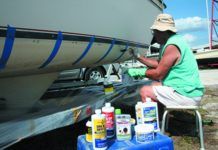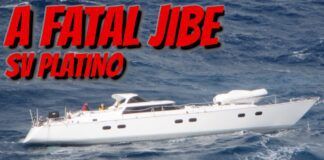Leisure furl Experience
Following your advice (August 1, 1998 review of Leisure furl, Profurl and John Mast ) I purchased a Leisure furl in-the-boom mainsail furling system. If it is the best available, then in-the-boom furling has not yet matured. While most of the system is a work of art, there were some significant errors made, and the lead time was atrocious. It was four months to the day from the time I ordered it until it was built in New Zealand and shipped from California.
Since Im pretty handy and the nearest boatyard is over 200 miles away I decided to install it myself and Im glad I did. I guess it saved me about $2,000 in legitimate costs and another $1,000 in error correction.
The biggest problem was that the fasteners which hold the luff extrusion to the mast were far too big to fit. They sent a second set of fasteners and with a couple hours of grinding I was able to make them fit. Without the help of Alan Massey at Forespar I never would have gotten all the pieces right.
Alan procured a sail for me from a sailmaker he knew would follow some apparently unusual instructions. This sail is very good. Performance is at least as good as with my old sail. On a trip down the Columbia River we were pounded with winds to 53 knots and got good performance with the sail raised to half its height. On the old sail, the deepest (second) reef would still have been too much.
The biggest problem is lack of luff tension. Only by putting a lot of tension on the halyard when the sail is furled will the sail wind up tight enough, which means putting a lot of tension on the furling line, too. After rolling up the sail with inadequate tension and then going through a vigorous gybe with a reefed sail there was about a foot of luff hanging loose between the sail spindle and the bottom of the luff groove. Even with the sail at full hoist, luff tension disappears when either the sheet or the vang is pulled down hard.
On the other side of the same issue, there has to be considerable pull on the furling line when the sail is being hoisted so the last wrap on the spool wont cut down between inner wraps and jam when the furling line is winched tight.
On the positive side, it is good to be able to put up exactly how much sail I want and it is wonderful that no one has to go on deck to gather a sail when the boat is being thrashed by wind and wave. Also, it is much less sensitive to boom angle while furling than the instructions led me to believe and I enjoy not having to look around a bulging sail cover if I stand to steer while motoring.
I recently installed an electric winch to be used for both hoisting and furling the sail and I am very pleased with the result. It was an unexpected expense but the positive side is that the sail goes up and down easily and the winch is available for other purposes.
Ed Reed
Kennewick, Washington
We asked Alan Massey, Leisure furl project manager for Forespar Products in Rancho Santa Margarita, California, to respond to Mr. Reed. His comments follow:
Forespar recently moved manufacturing of the Leisure furl from New Zealand to its facility in Southern California. This has alleviated the excessively long lead times previously required. Current lead times are running approximately four weeks from time of order. All Leisure furl systems are custom built to order and normally require professional installation. Forespar made an exception for Ed because of his remote location.
While we are happy that Ed is now pleased with the operation of his Leisure furl, one must understand the importance of maintaining adequate line tension on the halyard while furling and on the furling control line while hoisting the main. Eds vigorous gybe caused the furled portion of the main to furl tighter on the mandrel and created a loose luff. Fully battened furling mainsails need to be evenly and neatly rolled. Without adequate tension on the main halyard while furling, the main can loosely roll and cause a loose luff later when under load.
When hoisting, tension on the furling control line is needed to maintain proper luff tension and to maintain consistency of the remaining furled portion of the mainsail. The installation manual recommends the use of a snubbing winch or a horn cleat to control line tension. Depending on the strength of the crew and the size of the mainsail, a powered winch may be recommended.
Basic installation of the Leisure furl for a mid-30-foot boat should be around 20 hours of a riggers time. Installation of additional upgrades or equipment such as a powered winch or relocating deck hardware can require additional hours and cost.
Downsizing
After reading Dan Spurrs editorial in the March 2000 Practical Sailor, All Things Must Pass, I realize my (or his) experience is not unique. I have owned progressively larger sailboats over a 20-year period, envisioning major cruising. My last large boat was a Tartan 372, set up for long-distance cruising. I did go from Norfolk, Virginia to Bermuda and a few other places, but for me, just as it was for Dan, the expense, the labor of large sails and equipment and time constraints convinced me to sell my boat.
I downsized to an F-31 trimaran, which I love. Its easy to handle shorthanded, trailerable to other new sailing grounds, inexpensive to maintain (on a trailer in the winter, safe from the elements) and just plain fun. I had become so entangled in the offshore dream that I forgot what fun it is to just plain sail until…I downsized!
David Lannik
via email
I read your account of the passing of Viva with interest, while in my minds eye I had a vision of Mariah. She is the solution I arrived at when faced with the desire for comfort and speed under sail, ample space and accommodations below for a cruising couple, and the ability to be singlehanded when necessary by a retiree. Mariah is a 1981 Nonsuch 30. She was purchased in November 1997 for $35,500 in sound but neglected condition. A good cleaning, rebuilding the head, repairing diesel leaks, replacing all running rigging, replacing and supplementing electronics and installing a windlass have brought her back to life. They come in sizes from 22′ to 36′. Your time can come sooner than you think.
Dave Calder
Sudbury, Massachusetts
SS Fasteners in Aluminum
Another way to attack the problem of stainless fasteners seizing in aluminum and in other stainless (April 15, 2000), is to hard chrome plate them. This is a long standing fix from the aerospace industry. Here is how its done: Look under plating in your local Yellow Pages to find a company that does Hard Chrome. When you take the fasteners in to be plated, hand them written instructions. The plating company should: 1. Glass bead blast with about 50 lbs. pressure. 2. Passivate the fasteners before plating (passivating is soaking in a solution of nitric acid). This dissolves all surface carbon and retards rusting. 3. Plate .0001/.0003″ thick with hard chrome directly on the base metal-no under layers of copper or nickel.
If you have nuts and bolts, leave the nuts home. Use Loctite.
Steve Peterman
Multichrome/Microplate Co., Inc.
Inglewood, California
Spring Cleat
Your May 15 issue again raised the importance of having midship cleats on a boat. Our product, Springcleat, reviewed in your March 1997 issue, was not mentioned. The Springcleat attaches to the toerail at two points, allows two lines to be used with ease, and is snagproof. Since your review we have improved the welding using tig welders. We sell direct at $36 per unit including all hardware.
Ron Benveniste
Spring Cleat Canada
Montreal, Quebec, Canada
Where Credit Is Due…
To Pioneer Research, Moorestown, New Jersey: My Steiner 7×50 w/compass binoculars became rusty in the right side and the compass was hard to read. Even though they were over five years old when I called Pioneer Research, I was told to send them in and they would send me a new pair at no charge. They were not very fast and had to be called several times, but they did honor their word by upgrading me to a pair of Commander IIIs at no charge.
C. Webb
Royal Palm Beach, Florida
To Gill North America, Buford, Georgia: In the fall of 1998, I purchased a Gill Breathable Antigua jacket. Nice coat, worn only infrequently. A few months ago, I noticed that the inner collar area, originally bright red, had lost its color, becoming for some strange reason, white and blotchy. On a whim, I called Gill and spoke with Kathy in customer service. Usual questions about hair treatment (Im a baldy, using no hair oil), suntan oil (use a 45, but can’t remember using it while wearing the coat, which is for rainy, not sunny weather anyway). Kathy said to mail the coat to Gill for inspection. Eight days later, UPS delivered a brand new jacket, no bill.
Rick and Burdenna Brown
Longboat Key, Florida









































